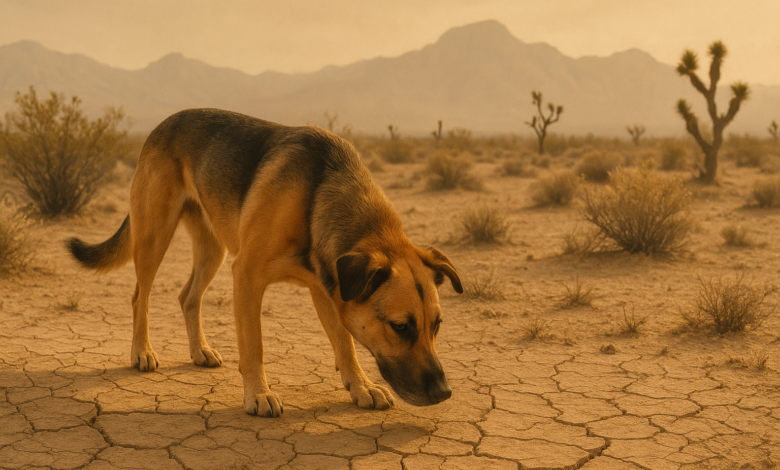We may earn a commission when you click on links across our website. This does not influence our opinions — learn more.
Is Valley Fever a Risk for Dogs in Las Vegas?

If you’re a dog owner in Las Vegas, you’ve likely heard of Valley Fever — maybe from your vet, a neighbor, or even a scary headline online. Officially known as coccidioidomycosis, Valley Fever is a fungal infection caused by the Coccidioides organism, which lives in dry desert soil. And while it’s often associated with Arizona, Las Vegas does sit squarely in the fungus’s geographic range. So, the real question is: should dog owners in southern Nevada be concerned? The short answer is yes — but let’s break it down.
Why Dogs in Vegas Are Vulnerable
Valley Fever isn’t some far-off threat if you’re living in or visiting Las Vegas. The area’s hot, arid climate makes it a natural host for the Coccidioides spores. These spores live in the top layers of soil and can be stirred up into the air when the ground is disturbed — like during construction, windstorms, or even just when your dog is digging around in the backyard. Las Vegas tends to get occasional bursts of heavy rain followed by long dry spells, which creates the exact conditions this fungus needs to thrive. And once the soil dries and cracks, spores become airborne — ready to be inhaled by a curious pup with its nose in the dirt.
Dogs that love to dig, sniff around dusty yards or trails, or play in open desert areas are especially at risk. Unlike humans, who usually wear shoes and don’t stick their faces in the soil, dogs have a much more direct route to exposure. While not every dog will get sick even if exposed, those that do can face a long road to recovery if the infection spreads beyond the lungs.
Symptoms to Watch For
One of the tricky parts about Valley Fever is that its symptoms can look like a lot of other illnesses — especially in the early stages. Most dogs show signs one to three weeks after inhaling the spores, but in some cases, symptoms might not appear for months or even years. The infection often starts in the lungs, so a persistent cough is usually the first red flag. Other early signs include lethargy, a mild fever, and a noticeable drop in appetite.
If the fungus spreads throughout the body — a condition known as disseminated Valley Fever — the symptoms can get much more serious. This includes painful joints (often showing up as limping or lameness), swollen lymph nodes, skin sores, eye problems, or even neurological symptoms like seizures. It’s easy to mistake this for other chronic conditions, which is why awareness is so important for pet parents in the Las Vegas area.
How Common Is It in Las Vegas?
Valley Fever is far more common in places like Phoenix or Tucson, where some counties report infection rates as high as 10% of dogs per year. But southern Nevada isn’t immune. While we don’t see as many cases as Arizona, infections absolutely do happen here. In fact, the geographic range of Valley Fever has been expanding, with cases now popping up in parts of the West that previously saw few or none. Las Vegas is already within the known endemic zone, so it’s smart to assume there’s some level of background risk — especially in newly developed areas where soil is frequently disturbed.
How to Reduce the Risk
The good news? There are some simple ways to reduce your dog’s risk of exposure — none of which involve keeping them cooped up all day. First and foremost, avoid letting your dog dig or play in dusty, bare-soil areas, particularly after windy days or major landscaping. If your dog loves being outdoors, stick to parks with grass, gravel, or artificial turf. You should also avoid walking your dog during dust storms or immediately after one.
If your dog starts showing symptoms — like a dry cough, unusual tiredness, limping, or fever — get them checked out by a vet as soon as possible. A blood test called a coccidioides antibody titer can help confirm whether your dog has been exposed or infected. If the result is positive, treatment typically involves antifungal medication like fluconazole or itraconazole, and it can last anywhere from six months to over a year depending on how serious the case is.
What Treatment Looks Like
Treating Valley Fever isn’t a quick fix. Most dogs need daily antifungal medications for several months, and your vet will likely monitor their progress with periodic bloodwork. Fortunately, if caught early and treated properly, most dogs make a full recovery — especially those with infections limited to the lungs. Over 90% of respiratory cases have a good outcome. But in dogs with widespread disease (like bone or neurological involvement), the prognosis can be more guarded, and lifelong medication may be needed.
A Vaccine May Be on the Horizon
Here’s something to look forward to: researchers at the University of Arizona, in partnership with Anivive Lifesciences, have developed a promising Valley Fever vaccine for dogs. In early trials, the vaccine provided strong protection against the fungus, and if all goes well, it could receive USDA approval in the next year or two. Once it’s on the market, it could be a game-changer for dogs living in endemic areas like southern Nevada — especially for those with outdoor lifestyles or weakened immune systems.



